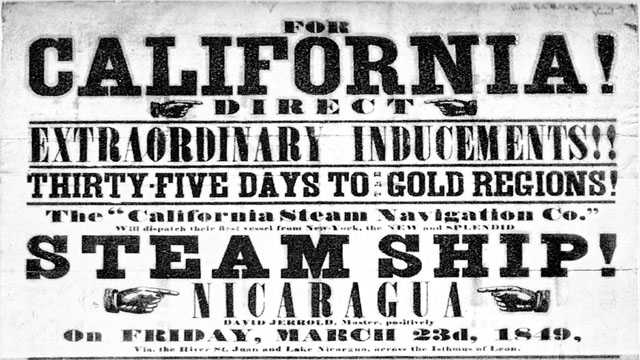The Gold Rush |
Article
The California Gold Rush
Sandwiched between the Louisiana Purchase in 1803 and the Civil War in 1861, the California Gold Rush is considered by many historians to be the most significant event of the first half of the nineteenth century.
An 1849 handbill from the California Gold Rush. PD. Military governor Colonel Richard B. Mason. Courtesy: Doug Scougale
Military governor Colonel Richard B. Mason. Courtesy: Doug Scougale
Spreading the Word
Word of the gold next reached places most accessible to the California coast by ship. Thousands of people from the Sandwich Islands (Hawaii), Oregon, Mexico, Chile, Peru and China headed for California in the summer and fall of 1848, before Americans on the East Coast had a clue of what was to come. Europeans would soon follow.
State of the Union
On the East Coast newspapers first published accounts of the gold discovery in mid-summer 1848. Skeptical editors downplayed the notion, despite letters from California like the one in the September 14 issue of the Philadelphia North American that read, “Your streams have minnows and ours are paved with gold.” Not until President James K. Polk announced Colonel Mason’s report in his December 5, 1848 State of the Union address did Americans become believers.
Never Dreamt of Wealth
Suddenly, thousands of Americans (mostly men) borrowed money, mortgaged homes, or spent their life savings to take advantage of an opportunity they never dreamed possible. In a society that was becoming increasingly based on wage labor, the idea that a person could alter his destiny by collecting gold off the ground proved irresistible. Some American women, among them Luzena Wilson, went to California, but most stayed home. The women left behind took on responsibilities they had never anticipated, such as caring for families alone, running businesses, and managing farms.
A Rush of Gold Seekers
By 1849, the non-native population of California had grown to almost 100,000 people. Nearly two-thirds were Americans. Upon arrival in California, immigrants learned mining was the hardest kind of labor. They moved rock, dug dirt and waded into freezing streams. They lost fingernails, got sick and suffered malnutrition. Many died of disease or by accident. Hiram Pierce, a miner from Troy, New York, conducted a funeral for a young man from Maine who died of gangrene after carelessly shooting himself in the leg.
Sucker Flat
Despite the relentless work, the promise of gold drew more miners west every year. Towns with names like Hangtown, Sucker Flat, and Murderers Bar sprouted in every promising crevice of the Sierras. Within a few years, the little port of San Francisco became a raucous frontier metropolis with a lively economy and California was named the 31st state.
Millions in Gold
An astounding amount of gold was pulled from the ground: $10 million in 1849, $41 million ($971 million in 2005 dollars) in 1850, $75 million in 1851, and $81 million in 1852. After that, the take gradually declined until 1857, when it leveled off to about $45 million per year. The fortunate bettered their circumstance, but mining required, above all, luck. And not everyone got lucky.
White Men’s Gold
Part of the difficulty for the individual miner was competition. As the mining region grew more crowded, there was less gold to go around. Anglo-American miners became increasingly territorial over land they viewed as meant for them and forced other nationalities from the mines with violent tactics. As for California’s native people, one hundred and twenty thousand Native Americans died of disease, starvation and homicide during the gold rush.
Fading Dreams
As the surface gold disappeared, individual miners found their dreams of cashing in on the gold rush growing more elusive. Many men went to work for the larger mining companies that invested in technology and equipment to reach the gold that lay below the surface. By the mid-1850s mining for gold had become less an individual enterprise and more a wage labor job.
Invasive Technique
The large mining companies were highly successful at extracting gold. Using a technique called hydraulic mining, they extracted $170 million in gold between 1860 and 1880.
In the process, they devastated the landscape and choked the rivers with sediment. The sediment washed downstream and flooded farmlands, ruining crops.
A court ruling brought an end to hydraulic mining in 1884, and agriculture took over as the principal force behind the California economy.
Source link : http://www.bing.com/news/apiclick.aspx?ref=FexRss&aid=&tid=66dd00501ca94b9a9f2ee939a7215e43&url=https%3A%2F%2Fwww.pbs.org%2Fwgbh%2Famericanexperience%2Ffeatures%2Fgoldrush-california%2F&c=8327170728615340546&mkt=en-us
Author :
Publish date : 2017-10-12 05:04:00
Copyright for syndicated content belongs to the linked Source.






